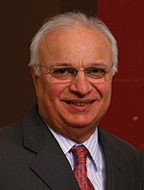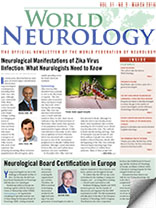
Raad Shakir
Is there a place for a general neurologist? The time has come for us to have a fresh look at our specialty and decide whether we need to modify how we train and practice. In most parts of the world, the answer to the question is simple: We need to continue to train general neurologists to cover a huge need. There are so few of us, that we cannot afford the “luxury” of subspecialization. However, in a minority of countries, the field has expanded to the degree that subspecialists are the norm. The issue is that, in such a diverse situation, for the vast majority of the world population, we are only providing basic neurological care. Do we have to accept the less optimal situation, or should we push hard for subspecialization to happen worldwide?
There is no doubt that in many parts of the world, the idea of a general neurologist is fast receding. The argument is that the enormous change in practice and the need to be able to deal with complicated issues is far beyond the capability of a generalist.
The explosions in genetics and imaging have led to the need for an in depth knowledge of a rapidly changing field. The generalist can decide on the primary clinical presentation and then what direct management is necessary. However, there will come a point where his or her abilities will not be sufficient to advise further.
If we take the example of acute neurological care: How many neurologists are capable of administering tPA in acute ischemic stroke or feel able to do so? The technology has been available for nearly two decades, and up till now, few centers, even in the developed world, are able fully to provide the required treatment not only in tPA provision but also more specialized intravascular thrombectomy. It is true that we need a highly sophisticated technical support from interventional radiology to neurosurgery. But the fact remains; there should be on-the-ground expertise far beyond the training and confidence of a general neurologist.
The field is now so complicated that a generalist feels uncomfortable in dealing and advising, for instance, on the use of disease-modifying therapy for MS. The plethora of licensed drugs makes it very difficult to advise on the suitability of certain long-term expensive medications. Moreover, side effects of disease-modifying drugs require care at special centers with neurologists and specialist nurses to look after the needs of patients.
Moving to other common conditions, such as epilepsy, we are all trained in the diagnosis of epilepsy, despite the complexity of seizure semiology. However, it is also true that in many cases, there are inevitable errors in diagnosis leading to erroneous management. Therefore, it is important that specialist epilepsy services are available for referral of the difficult, of the poorly controlled or for those needing surgical intervention. This means we need to train specialists in the field of epilepsy to provide accurate and appropriate care.
The world of movement disorders has really moved on. We are now in a new era of deciding on correct diagnosis and then advising on management. The field is even more complex with the availability of surgical interventions. It is true that a general neurologist is fully able to make a correct diagnosis of rather complicated Parkinsonism syndromes, but when it comes to decisions on the suitability for deep brain stimulation or Duodopa therapy, then expertise in the field is mandatory. This makes the need for specialist referral centers necessary if we are to offer full treatment packages to patients.
The diagnosis and management of genetically derived disorders is another major area for the specialist. The generalist is in many cases able to decide on the clinical phenotype, but that will need a further in-depth look at the genetics and will require a neurogeneticist to give advice on mode of inheritance and progression following appropriate DNA analysis. This is not an area to venture into without full training in clinical genetics, especially if there are predictive tests in healthy carriers and the implications of that on life and childbearing in future generations. The most important issue perhaps is the increasing possibility of the availability of stem cell and genetic modifications in combating many neurological conditions.
Many CME programs are aimed at updating the neurologist in dealing with the conditions faced in daily practice. If we look at the programs of the major international, regional and national neurological congresses, we see that specialists in various fields impart their knowledge and advice to general neurologists. This has led to a plethora of guidelines, with which neurologists are being bombarded, and, at times, it is very difficult to apply the most up-to-date pathways to every problem faced. These guidelines are aimed at practitioners in general, but in most parts of the world the contained technologies are, by and large, not available and therefore the supposed “best practice” is not applicable. This means that many neurologists looking after huge populations, however diligent they may be in keeping abreast of the latest guidelines, are totally unable to follow them and subsequently, their patients are disadvantaged.
Logically, it follows that postgraduate teaching material and guidelines have to take into account the fact that not all that is most up to date is applicable in all situations. The requirement of obtaining enough annual CME is only effective if it is targeted to the individuals concerned. The general neurology societies and continental associations have to produce guidelines which are for the general neurologist, and which may well be different in a way to those targeting the specialists in the field. This is rather difficult and may lead to confusion and errors.
Unfortunately, in many parts of the world, there is little opportunity for patients to see the neurologist of their choice. This is very common in both resource rich and poor countries. The healthcare systems in many, if not the majority of resource rich settings, provide neurological care in an anonymous way, and the patient referred with a specific problem may be seen by a general neurologist or by someone with a different special interest. In the grand scheme of things, this does not matter as neurologists know their field and can ask for advice as and when required.
However, in resource poor settings, the way in which patients are seen by neurologists varies considerably. Some neurologists sit in crowded outpatient clinics, where tens of patients wait in line, and where it is only possible to give each of them only a minuscule amount of time. In some settings, this is compensated for by the availability of inpatient beds, and what may seem like a complicated problem in the crowded outpatient setting can be admitted for a more detailed evaluation and more thorough investigation.
In other settings, neurology is by and large an outpatient service, with large, short-stay and smaller long-term inpatient facilities that vary according to locality and country. Looking after long-term disabled patients is dependent on the availability of ancillary services. Neurological rehabilitation is a separate specialty, which is totally dependent on the close collaboration with physiotherapists, occupational therapists, speech and language therapists, neuropsychologists and neurology nurse practitioners. Without that, delivery of a comprehensive package of care is not really complete. This approach may not satisfy the expectations of patients who, in the age of the smartphone, have access to the latest advances and will demand care, which may not be possible in their settings. This may well be useful for neurologists, as it will create pressure on health authorities to provide financial and manpower support to achieve better results. This is why it is crucial to work with patients’ groups to push for change at all levels.
Now we have to come to the crux of the matter: Do we now have a two-tier neurological practice, or is it a continuum of evolving care starting with the general neurologist and narrowing expertise to the highly skilled specialist? Moreover, how do international bodies like the WFN, as well as regional and national organizations, influence and promote the evolution? Alternatively, should we decide that the deficiencies we face are so enormous that they are insurmountable and we have to get on with improving what we have and let slow evolution take its course? There is probably some truth in the latter view as the financial cost across the world is so vast, that we have to keep plugging away with our programs and slowly increase the number of neurologists in resource poor settings, eventually leading to specialization in our field and reducing the huge treatment gap that now exists.
To answer the question raised in the first paragraph, for the time being, it is a clear, yes there is a place for a general neurologist.
